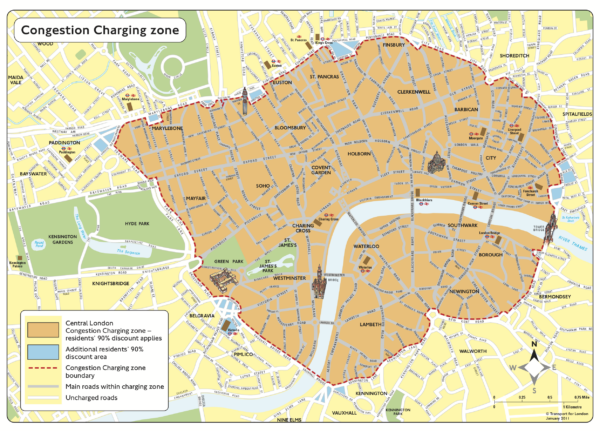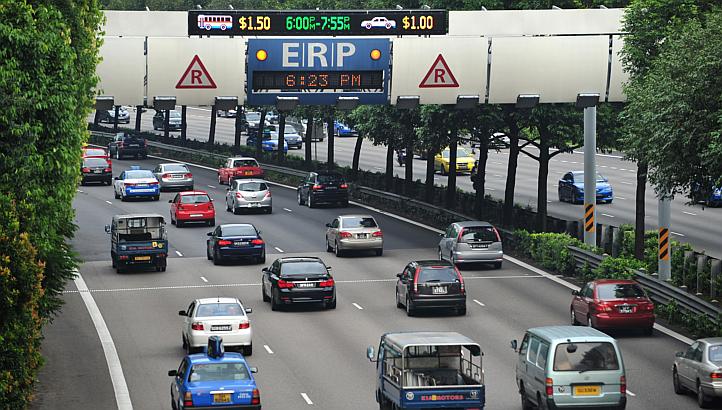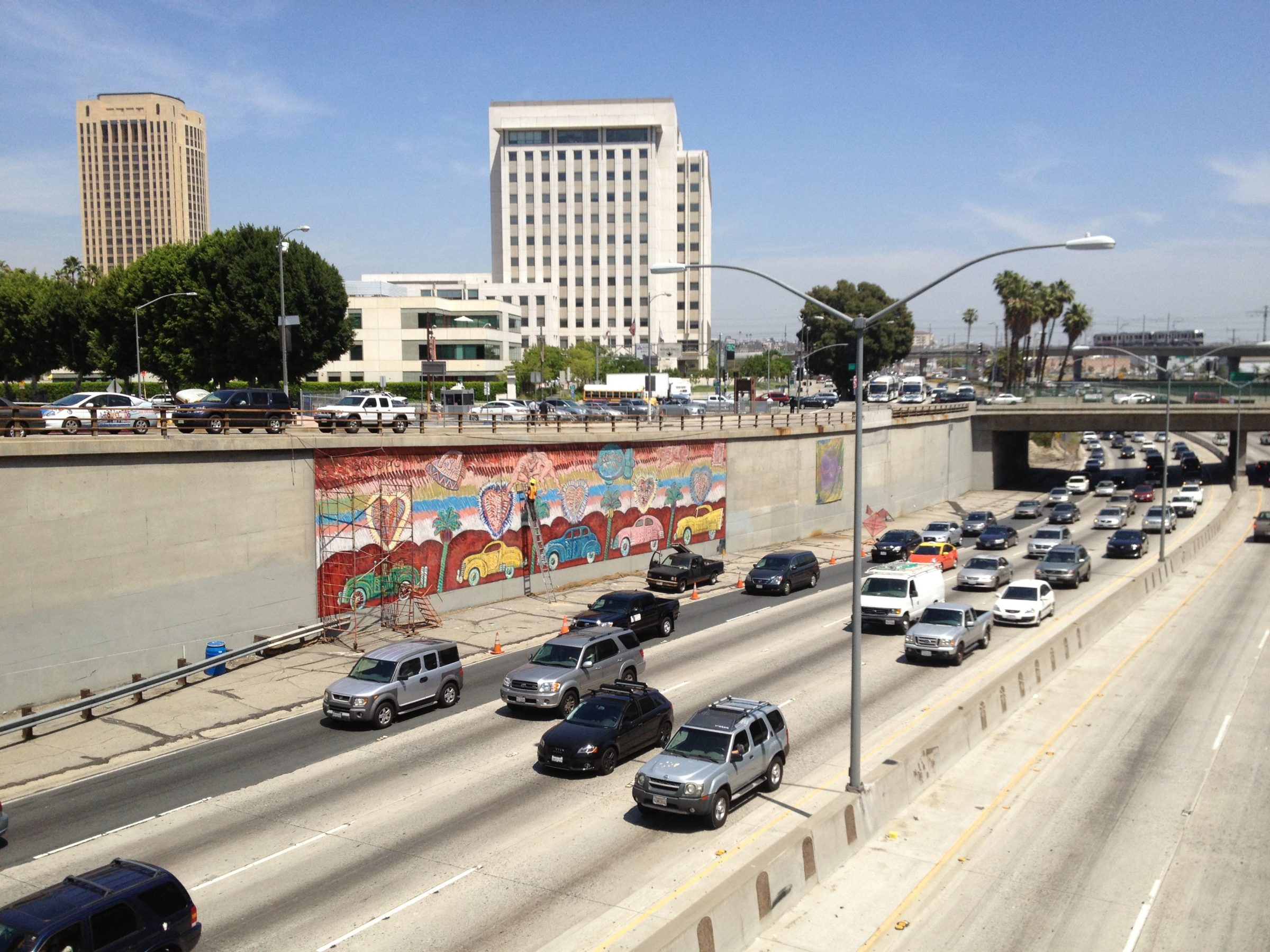When Measure M was on the ballot almost three years ago, voters were told that its passage would help ease congestion in traffic-choked Los Angeles. Since its passage we’ve seen the unprecedented rail construction across the region, but still the average LA driver spends 100 hours stuck in traffic every year. What are some other solutions?
Congestion pricing is one traffic management tool. It uses price to incentivize would-be drivers to travel differently at busy times of day by charging actual drivers a fee for using certain routes. Just as gasoline prices go up before long weekends to prevent a gasoline shortage, traffic congestion prices would fluctuate to address high-demand — in this case, vehicle demand for road space. Case studies show that in addition to alleviating traffic, congestion pricing reduces greenhouse gas emissions and traffic crashes — a trifecta of important benefits for LA County.
Last December, LA Metro’s chief executive officer, Phil Washington, and his staff introduced the LA Metro Board to congestion pricing as a potential way to fill a $26 billion funding gap to complete a suite of 28 LA Metro projects that the LA Metro Board seeks to finish before the 2028 Olympics and Paralympic Games in LA. Last month, Mr. Washington and the LA Metro Board took a different approach and focused on the concept of charging drivers as one possible and very bold way to get rid of vehicle congestion in LA and possibly even fund free transit. Yet details on how that would happen are still being discussed.
Congestion pricing in LA today
Metro already operates high-occupancy toll (HOT) lanes or “ExpressLanes” on portions of the I-10 and I-110 freeways. Solo drivers can choose to pay a price to bypass drivers in the toll free/regular freeway lanes by instead driving in the designated ExpressLanes where operators guarantee a desired average travel speed set by LA Metro. Carpoolers that fulfill the minimum occupancy requirements (2 or more persons) may drive in HOT lanes toll free. Some of the most reliable public buses in LA also operate in the HOT lanes, such as the Silver Line which runs on-time around 90 percent of the time.
Metro offers low-income drivers a one-time subsidy when enrolling in the ExpressLane program, if applicants are able to prove their eligibility. Metro also seeks to mitigate the health burden imposed on low-income communities situated next to freeways by committing proceeds of toll revenue to city active transportation and transit projects serving communities within three miles of the toll lanes. This last point is an important component to a successful congestion pricing model: investing in accessible and reliable transportation choices for people to get around without driving their car.
Congestion pricing models
Below are three models of congestion pricing that Metro is currently studying for feasibility.
Cordon pricing — Drivers pay program operators a fee to drive into a designated area. Cordon pricing programs exist today in Singapore, London, and Stockholm. Cordon pricing models work when lots of drivers routinely enter a centralized (business) district with many transportation alternatives to driving. For instance, the Bay Area bridge tolls are a form of cordon pricing to enter San Francisco from other cities. Because jobs in LA are concentrated in numerous districts across the county, a cordon pricing model could be less appropriate in LA than other models. Downtown LA is the only jobs-rich area with many viable transit alternatives to driving. LA Metro estimates a cordon pricing program centered on downtown LA could generate up to $1.2 billion per year in revenue.

Corridor pricing — Drivers pay program operators a fee to drive at a steady speed in any lane on a priced road corridor. LA ExpressLanes are a miniature version of a corridor pricing program. As with ExpressLanes, fees would be distance-based and time-based: digital signs present drivers with a cost to the next major exit when entering the facility (calculated behind the scenes by cost per mile) and electronically charge drivers once they pass sensors as they exit the facility. Because many road corridors become congested all over LA, a corridor pricing model, if implemented correctly, could present people in LA with impactful health and safety, among other, benefits. As the Metro research paper on this topic suggests, appropriate test corridors in LA could include portions of the I-101 freeway where it parallels the Metro Red Line and I-10 freeway where it parallels the Metro Expo Line. Agencies have not yet released revenue estimates for the corridor pricing model because too many variables remain undefined at this point in time.

Vehicle miles traveled (VMT) pricing — Drivers pay road operators a fee to drive in excess of drivers’ allotted share of vehicle miles traveled. Agencies in California, Oregon, and Iowa have tested this model of pricing. Oregon’s test calculated the number of miles driven in a “congestion zone.” Although technology exists to implement this kind of pricing model, the model has not yet been implemented because of political challenges (Metro research paper). Because this model charges motorists according to miles driven independent of geography this model holds the greatest potential for alleviating traffic over a larger area. However, this model must thoughtfully consider land use and housing patterns in the region, as Los Angeles is increasingly seeing its more affordable places to live moving further away from job-rich areas. Revenue estimates for a region bigger than but principally including LA County reach as high as $10.35 billion per year. For comparison, Metro estimates Measure M generates $860 million in revenue per year.
What could congestion pricing accomplish?
Less traffic — Principally, the goal of congestion pricing is to alleviate chronic traffic on priced roads. As Metro’s congestion pricing primer paper states, traffic reduced by 20 percent in Singapore and 30 percent in London. In Stockholm, traffic reduced to 22 percent (down from 30-50 percent). As shown in LA Metro’s latest ExpressLanes performance report, drivers in LA’s ExpressLanes and bus riders who rode on the Metro’s Silver Line in the ExpressLanes traveled at speeds above LA Metro’s desired monthly average speed of 45 miles per hour.
Reduce air pollution — In addition to breaking-up vehicle congestion, congestion pricing could eliminate “elastic” vehicle trips that could be replaced by some other mode of travel. This lowers the total number of vehicle miles traveled, which reduces greenhouse gas emissions overall — a win for our planet and California’s legislative goals, to say the least. Over time, overwhelming driving (and parking) costs could incentivize widespread healthy, sustainable, and affordable living that seldomly requires car travel and hardly justifies car ownership.
Diminish disparities — Congestion pricing quickly and annually raises such large amounts of money that the revenue collected could transform how public agencies, including LA Metro, invest in transportation. When public agencies spend toll revenue in smart and equitable ways — by first spending on ways that improve transportation options in historically disinvested communities, people in the LA region as a whole enjoy more and higher-quality access to jobs, services, and life-enhancing opportunities. Public revenue raised by congestion pricing could be used to counteract decades of institutional neglect of vulnerable communities. At LA Metro, congestion pricing revenue could be used to do more than ask current staff to develop equity-informed recommendations to Metro Board. With Metro’s allocation of revenue raised by congestion pricing, Metro could hire equity-focused staff to teach and enforce equitable decision-making agency wide.
Criticisms
But to keep LA moving, we need viable and reliable alternatives to driving
True — successful implementation of any congestion pricing program requires prior and/or simultaneous implementation of viable transportation alternatives to driving alone. Congestion pricing models complement LA’s ongoing sales tax-funded initiatives. Congestion pricing models influence travelers demand for driving and its alternatives, including public transit. Meanwhile, LA’s sales tax-funded initiatives increase the supply of public transit service. Since over seven in ten people in Southern California “ride transit rarely or never, if one out of every four of those people replaced a single driving trip with a transit trip once every two weeks, annual ridership would grow by 96 million — more than compensating for the losses of recent years” (Manville, Taylor, and Blumenberg, 2018).
But would pricing roads divert traffic to other streets
Congestion pricing would serve as the incentive (on priced roads), while travel time on unpriced streets would simultaneously serve as the incentive (on unpriced roads) for drivers to travel differently. Drivers who might avoid priced roads by diverting onto unpriced roads might face long drive times that would themselves serve as an incentive to consider traveling differently.
But congestion pricing adds to the financial burden on low-income drivers
True — congestion pricing would add to drivers’ financial burden only if congestion pricing operators do not implement countermeasures to subsidize low-income drivers’ access to priced roads. Congestion pricing subsidies would extend (to low-income people who drive) a moral minimum mobility benefit that American society currently denies low-income people by not subsidizing their gasoline taxes or any of the (at least 9) other regressive ways we pay for transportation. Utility companies such as LADWP make sure people can access utilities regardless of income with lifeline services that subsidize low-income households’ access to water and electrical power, for example. Research shows that automobile access is as essential as utilities are to sustaining a lifestyle that can overcome economic disparities. The vast majority of drivers who need to drive and have means to pay congestion prices can instead help to achieve equitable outcomes with congestion pricing.
Congestion pricing, again, is only one tool in the traffic management toolkit. Using money as an incentive to change behavior requires thought and intention. Charging a toll to drive poses a choice on the traveler per trip. But behavior can only change without penalty if viable alternatives exist. Congestion pricing is effective when travelers can access and afford (in both time and money) to take transit, ride a bike or scooter, carpool, walk, or something else. We support thoughtful and intentional traffic management tools that do not impose additional burdens onto people who already have the fewest transportation choices.
Next steps
Get involved — LA Metro Board members will deliberate whether to commission a 2-year study on implementing a congestion pricing pilot someplace in LA County at the following 3 board meetings. These public hearings will take place in the Metro Board Room at One Gateway Plaza, Los Angeles, CA 90012, 3rd Floor at the following times.
- Wed. 2/20 at 2:00 p.m. — Planning and Programming Committee
- Thu. 2/21 at 11:30 a.m. — Executive Management Committee
- Thu. 2/28 at 11:30 a.m. — Regular Board Meeting








